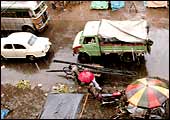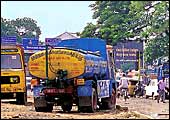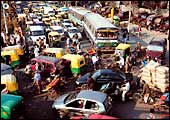 |
Mumbai,
mammon's favoured child, part of Charles II's dowry when he married
Catherine of Braganza in 1662, Shanghai-wannabe, is India's commercial
capital. All but 13 of the 30 firms whose stocks constitute the
Bombay Stock Exchange's Sensex are based in the city. In 2004-05,
corporate tax takings from Mumbai accounted for 41 per cent of
the total; personal income tax revenues, 33 per cent. And, according
to a McKinsey report, some 5 per cent of India's gross domestic
produce comes, directly or indirectly, from the city. With India
Inc. on a roll-revenues and net profits have been on an upward
spiral, and, for a sample of 107 companies, went up by 19.8 per
cent and 10.3 per cent respectively in the April-June quarter-and
the Sensex on fire, Mumbai should have been patting itself on
the back, preening, dreaming, as it lately has been of a Shanghaiesque
future, or flexing its financial muscle. Instead, on July 26,
the city, the thousands of companies that call it home, and its
15 million citizens all ran for cover.
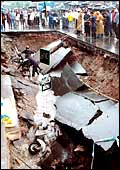 |
| Mumbai's dreams of a future like Shanghai
were washed away much like this road, one of several that
were damaged |
It rained on July 26 (and how). It rained
on July 27 (by the end of Day 2 Mumbai had seen some 944 cm of
rainfall). And, just when things looked like returning to normalcy,
it rained again on August 1. By August 5, 431 people had lost
their lives, 28 million man-days of business had been frittered
away, 1,500 flights had been cancelled, exporters were totting
up losses amounting to thousands of crores, and business had suffered
losses, real and notional, of over Rs 20,000 crore. Some 150,000
people, some of them India's best-known executives (think K.V.
Kamath of ICICI, A.M. Naik of L&T and Sanjay Nayar of Citigroup)
had their schedules thrown out of kilter; some, who called Mumbai
home were stuck in Delhi and Bangalore; others, from other cities,
were stuck in Mumbai with no way of getting back home (KSA Technopak's
Arvind Singhal, a Delhi-based CEO, spent 17 hours in a cab and
he can consider himself among the lucky ones). Of the few million
who went to work on July 26, believing that it was just another
wet Monsoon day in Mumbai, some spent the night in the office
or their cars, and most ended up walking home, often wading through
water that was neck-deep. By the end of it all, the world knew
Mumbai for what it was.
 |
| Three days after, the cows were out but
most shops and offices remained shut |
The world? Oh, yes, the world knew what was
happening in India and was concerned. Mumbai, after all, is home
to the Indian arms of the 700-odd foreign institutional investors
(FIIs) that have pumped in over $5 billion (Rs 22,000 crore) into
the Indian stock market thus far this year. Luis Miranda, President
and CEO of IDFC Private Equity, was in New York in the first week
of August and faced countless questions on the Mumbai floods.
"Every single meeting I go for, the first 10 minutes are
spent discussing Mumbai," he says. "There are questions
from (potential) investors on why the infrastructure is so bad."
The state government's reaction has been
fatalist at best, with Chief Minister Vilasrao Deshmukh-he believes
the damages do not go beyond Rs 501 crore-citing the volume of
rainfall as an excuse. Mumbai did receive an extraordinary amount
of rainfall on July 26 and 27 (944 cm in 24 hours to be exact),
and not too many (actually, no) Indian cities can cope with that;
yet, the problems have more to do with urban-planning and governance
failures than a freak natural phenomenon. To quote from a 2001
report put out by the Indian People's Tribunal on Environment
and Human Rights after it studied the feasibility of the Bandra-Worli
Sea Link and the subsequent reclamation work at the Mahim Creek:
"By disturbing the natural course of events and redrawing
the geography of the Mahim Creek, the link has gradually upset
the flow of effluents and floodwaters that drain into the Arabian
Sea. Experts say that this, in turn, may cause the Mithi river,
which starts upstream at Powai and runs along the Andheri Kurla
Road, to back up and cause inordinate flooding along the adjacent
areas."
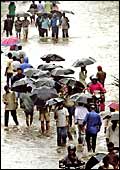 |
| Popular opinion goes that former Karnataka
CM S.M. Krishna's Bangalore-focus resulted in his party's
poor election show |
That is exactly what happened. And the damages
could be as high as Rs 20,000 crore. The city-based Indian Merchants
Chamber has put out its estimate of losses, between Rs 8,000 crore
and Rs 10,000 crore, but S.K. Saraf, Chairman, Federation of Indian
Export Organisations (FIEO), believes losses to exporters alone
(from loss of goods and indirect losses stemming from damaged
containers and roads) would tot up to that much (Rs 10,000 crore).
"The story isn't over yet," he says. "All feeder
roads to Jawaharlal Nehru Port Trust are blocked and there is
a 10-km long queue of trucks in Kalyan, so the damage is extending
way beyond the first week."
 |
| Most people walked home on July 26 and 27,
and several thousand passengers were stranded in Mumbai |
Then, there are intangible losses, things
whose impact cannot really be computed in Rs crore. Nicholas Piramal's
research centre in Goregaon was flooded; in the process, all cancer
cell lines the centre had cultivated were lost. "This puts
us back by around six months," says Swati Piramal, Director,
Nicholas Piramal.
Stories such as this abound, and all point
to one thing. Poor urban infrastructure could well be India Inc.'s
Waterloo.
Our Precarious Cities
Mumbai yesterday. Bangalore, Chennai,
Delhi, and Hyderabad soon.
No city in India
is fully equipped to handle a crisis of the magnitude that hit
Mumbai." That's the opinion of Bikash Ranjan Bhattacharya,
the mayor of Kolkata Municipal Corporation. Yet, the larger story,
behind Mumbai and behind smaller crises in other cities, isn't
one of ability to handle natural or man-made disasters. It is
one of poor urban infrastructure and administrative apathy. On
July 15, for instance, Hyderabad recorded 6 cm of rain in three
hours (a minor wetting compared to what was to come in Mumbai
later). The impact: most parts of the city were flooded waist-deep
and the road linking hi-tech hub Madhapur and the new commercial
district Somajiguda seemed more a waterway than a highway.
|
|
|
|
Commercial capital: See the wheels
of commerce turn?
|
Coping: Falling popularity saves
the city
|
| MUMBAI: A
Planner's Nightmare |
KOLKATA: Saved
By The Bell |
|
Power: Peak demand
2,000 MW per day; peak supply 2,000 MW per day
Water: Demand 3,900
million litres per day (MLPD); supply 2,940 MLPD. But capacity
will go up by 450 MLPD with the development of Bhatsa dam
Sewerage: 100 year old
drains that discharge water at the rate of 25 mm/hour; the
requirement is at least 50 mm per hour
Tele-density: 53 per
cent
Vehicular population: 1.29
million (2001)
Airports: Can handle
15 million passengers per year; however, the growth in the
number of flights (over 500 planes land and take off from
Mumbai's two airports every day) means the city desperately
needs another airport
Urban Planning: Most
planning concerns the island city, but the suburbs have
witnessed rapid growth; last development plan drafted in
1991. NGOs claim the city, with a carrying capacity (population)
of 1 million was hosting 15 million
For: "This kind
of rain happens once in 40-50 years; but we will have to
investigate what went wrong." Suresh Joshi, Commisioner,
Mumbai Metropolitan Regional Development Authority, MMRDA
Against: "We should
halt further construction until we have a completely chalked
out development plan for the city." Cyrus Guzder, Chairman,
AFL
|
Power:
Peak demand 1,300 MW per day; peak supply 1,300 MW per day
Water: A demand of 1,140
MLPD and a supply of 1,140 MLPD
Sewerage: A 969-km network
that can discharge 2,000 MT/day; still, the rain water drainage
system leaves a lot to be desired
Teledensity: 17.5 per
cent
Vehicular population: 850,000
Airports: Can handle
2.5 million passengers a year and 100 flight movements a day;
hasn't felt the pinch of growth (compared to Mumbai, Delhi,
and Bangalore, flights to and from Kolkata have increased
marginally)
Urban Planning: There
is significant growth in the residential real estate and retail
industry, but West Bengal hasn't really attracted as many
companies as Karnataka, Maharashtra, Delhi, and Andhra Pradesh.
Still, efforts are on to decongest Kolkata by building satellites
at Rajarhat and Howrah
For: "In the last
10 years things have improved. Several civic amenities are
now much better. Water logging is not as bad as it used to
be; and roads and public transport is better." B.K. Birla,
Chairman, B.K. Birla Group
Against: "The roads
have improved, but a lot more needs to be done on this front."
Sanjiv Goenka, Vice Chairman, RPG Enterprises |
The problems Mumbai faced on July 26 and
27 (and which parts of the city are still grappling with as this
magazine goes to press) appear to have less to do with a freak
meteorological phenomenon (a vortex over the city) than very avoidable
human interventions. Thus, it wasn't traditional low-lying areas
that were affected (as they are every year), but new ones such
as Bandra East, Kurla, Kalina, Goregaon, parts of Santacruz and
entire stretches of the Western Express highway. Most of these
border the Bandra Kurla Complex (BKC, where ICICI Bank, Citibank
and a clutch of others have their offices) neighbourhood; BKC
has witnessed rampant development over the past few years, and
several environmentalists and urban planners have cried themselves
hoarse pointing out the extensive damage this has caused to the
surrounding wetlands and the Mithi river that runs through them.
That no one had listened is evident from the fact that July 28
was the first most of its citizens even heard the river's name.
"There has been extensive destruction of mangroves (wetlands
that occupy upwards of 150 acres in and around BKC and serve as
a natural drainage system) illegally by builders," says Debi
Goenka, Executive Trustee, Conservation Action Trust, a non-governmental
organisation (NGO).
|
|
|
|
New IT hub: Ship of the desert,
anyone?
|
The South's capital: A whole new
meaning of 'dry"
|
| HYDERABAD: A
Commuter's Nightmare |
CHENNAI: Parched
Earth |
|
Power: Peak demand
of 1,106 MW per day that is largely being met
Water: A peak demand
of 900 MLPD and a peak supply of 810 MLPD
Sewerage: Traditional
rain water drainage network has been encroached on; the
city needs to invest in both sewerage and storm water drain
network. Today, the city generates an estimated 450 MLPD
of sewage and only a fourth of that can be treated in the
existing facilities
Tele-density: 27 per
cent
Vehicular population: 1.5
million
Airports: The city
airport handles around 60 flight movements a day; a sorely-needed
international airport has been in the pipeline for some
time.
Urban Planning: There
is no zoning to speak of; development is haphazard
For: "Several initiatives
are in the pipeline for removing encroachments, strengthening
the storm water drain infrastructure and improving the public
transport system." N.V.S. Reddy, Project Director (MMTS)
and Additional Commissioner, Municipal Corporation of Hyderabad
Against: "On an average,
commuting time in Hyderabad must have doubled in the last
one year." S. Sivakumar, Chief Executive (IBD), ITC
|
Power:
Peak demand 1,500 MW per day; peak supply 2,000 MW per day
Water: Demand of 600-620
MLPD and supply of 210 MLPD
Sewerage: The existing
sewage and rain water discharge system dates back to the 19th
century; once motorable water bodies such as Buckingham Canal,
Covum River, and Adyar River have become cesspools of sewage
Teledensity: 14 per cent
Vehicular population: 1.6
million
Airports: Together, the
two terminals (international and national) handled 5.5 million
passengers in 2004-05. The domestic terminal is in desperate
need of an upgrade; on an average flights hover for 20 minutes
before landing
Urban Planning: The Chennai
Metropolitan Development Authority (CMDA) has been given a
wide charter, but has achieved little
For: "Chennai's a great
place to work. While the influx of people into the city may
create problems now, they also bring many new opportunities."
Joseph Sigelman, Co-CEO, Officetiger
Against: "Water shortage
is acute in the city. Then, Chennai's internal waterways have
also not been cleaned for a long time." C.B. Rao, Deputy Managing
Director, Orchid Pharma |
In a city where land is scarce-the per capita
space available in Mumbai is 86 sq. ft., among the lowest in the
world; it is 129 sq. ft. in Delhi-a combination of the government-of-the-day's
desire to maintain Mumbai's standing as India's commercial capital,
increased immigration of white- and blue-collar workers looking
for better prospects, and plain greed have conspired to create
a situation where the only cure will require tough decisions (such
as new zoning laws) of the kind no one wants to take. Worse, much
of the land being auctioned off by the mills is in low-lying areas.
"The mill land development in Parel is only going to lead
to more and more flooding," rues Cyrus Guzder, Chairman,
AFL, a logistics company. "Over the last few decades, Mumbai
seems to have followed no masterplan for growth and conformed
to no structured lines of development," says A.M. Naik, Chairman
and Managing Director, Larsen & Toubro. "The deluge just
confirmed what many of us have known all along, that the city's
infrastructure has not kept pace with its expansion." The
government of Maharashtra may have woken up to the problem-"The
Chief Minister has said we will have to relook at all development
control rules," says Umesh Chandra Sarangi, Principal Secretary
to the cm's Office-but fact is, every major Indian city is, in
its own unique way, unfit for business. Bangalore's infrastructure
has collapsed under the pressure of rapid growth; Chennai hasn't
had enough water for almost a decade now; and Delhi, which abdicated
its role as the centre of industry in its part of the country
to satellites Gurgaon and Noida, is now watching the two implode.
"Fact is we have triple back-up for power and double back-up
for telecom and we also bear the additional cost of ferrying people
from and to work," says Pramod Bhasin, President and CEO,
GECIS, India's largest business process outsourcing (BPO) firm,
which is based in Gurgaon (Haryana), a satellite of Delhi that
has almost no public transport. "All of this corrodes India's
competitive advantage," he adds. That it does. For instance,
Ramakrishna Karuturi who owns and runs one of India's largest
floritech companies loses out on a few tens of crores every February
when Bangalore's poor airport infrastructure means that he cannot
meet the global Valentine's Day demand for roses. He has the flowers,
but cannot send them out within 72 hours of harvesting, not unless
he ships them from Bangalore to Mumbai and then out.
|
|
|
|
Fast lane: Not really, says Hoekstra
|
Seat of power: But roads of misery
|
| BANGALORE: Growth
Paralysis |
DELHI: Capital
Woes |
|
Power: Peak demand
of 1,200 MW of which some 930 MW is met
Water: Demand of 930
MLPD and a supply of 800 MLPD; set to improve once Stage
IV of the Cauvery Project is fully completed
Sewerage: Underground
sewerage, introduced in 1922, covers a large chunk of the
city, but lack of maintenance is evident during monsoons
Tele-density: 11 per
cent
Vehicular population: 2
million
Airports: The city's
one airport has been leased out from the defence ministry;
a new international airport has been in the works for the
past 17 years
Urban Planning: Bangalore
has the room to grow, but unplanned growth has led to chaotic
development, especially in south and east Bangalore
For: "Bangalore is not
Karnataka. There are just seven million people in Bangalore
as opposed to 55 million in Karnataka." H.D. Deve Gowda,
Former Prime Minister
Against: "Why is the
government inviting more companies to set up base here even
as it fails to provide even basic infrastructure for existing
companies?" Bob Hoekstra, CEO, Philips Software
|
Power:
Peak demand of 3,626 MW of which the city generates only 1,800
MW; peak supply of 3,626 MW met by tapping other states
Water: Peak demand of
3,859 MLPD and peak supply of 3,110 MLPD
Sewerage: A discharge
capacity of 1,433 MLPD; however, rainfall of 35.8 mm on August
4, left many parts of the city flooded
Teledensity: 65 per cent
Vehicular population: 4.2
million
Airports: Delhi has two
airports that together handle 500 flight movements a day.
The domestic airport is under some strain, but has room to
grow
Urban Planning: Good,
despite having a host of bodies that fall under two separate
governments (Delhi and Union); traffic has eased following
construction of 30 overpasses on the Ring Road and the Metro
Rail has made a difference.
For: "We are setting
up three power plants that will help meet projected 5,000
MW power demand by 2010." Haroon Yusuf, Power Minister, Delhi
Against: "We have no
issues with Noida where our manufacturing plant is. The problem
is in the movement of traffic and poor quality of roads on
the Delhi side." Ravinder Zutshi, Deputy Managing Director,
Samsung India |
There are other similar examples from other
cities. Then, the problems they highlight-inadequate power, water,
public transport; poor urban planning-are not new. However, when
they threaten to bring business to a grinding halt, as the rains
did in Mumbai in the last week of July, it is time for everyone,
lay people, businessmen, politicians and administrators to ask
themselves how things could have been different. Sadly, as the
Bangalore experiment shows, corporate participation in city improvement
initiatives doesn't always work (see Why Politicians Hate Cities).
As Peter Mukerjea, CEO, Star TV, says in the aftermath of the
Mumbai floods, "I think whatever had to be said by everyone
has been said; now it is over to the administration; let them
take the best of those ideas and get down to implementation."
-reported by Priya Srinivasan, Arnab
Mitra, Venkatesha Babu, Supriya Shrinate,
E. Kumar Sharma and Rahul Sachitanand
Why Politicians Hate Cities
Simple, because they do not elect them.
 |
| Popular opinion goes that former Karnataka
CM S.M. Krishna's Bangalore-focus resulted in his party's
poor election show |
See the man in
the picture? His name is Somanahalli Mallaiah Krishna. He is 73,
a senior leader of the Congress party that pretty much calls the
shots in the United Progressive Alliance government of the country,
and the governor of the state of Maharashtra. He was also, until
May 2004, the Chief Minister of the southern state of Karnataka.
The Congress didn't lose the general elections to the Karnataka
assembly that month; it just saw the number of seats under its
control decrease from 132 to 64, enough to force it to a position
where it had to share power with the Janata Dal (S), led by former
Prime Minister H.D. Deve Gowda. Most political analysts attributed
Krishna's loss (for that was what this was seen as) to his apparent
focus on Bangalore. The man had founded the Bangalore Agenda Task
Force (BATF), convinced professionals such as Nandan Nilekani
(the CEO of Infosys was Chairman of the task force) to be part
of it, and empowered them to work with city administrators to
improve the quality of urban infrastructure. The results were
evident in surveys conducted by market research firm TNS that
showed that most city residents believed the quality of civic
utilities in Bangalore had improved (see City in Sync, Business
Today, August 17, 2003). It seemed that Bangalore, and Krishna
were on to a good thing, despite criticism from opposition parties
that all this was being done to the exclusion of the rest of Karnataka.
Then, the elections happened, the Congress
saw a dip in its performance, and people like Deve Gowda were
quick to point out that they had been right all along and that
Krishna's alleged city-centric focus had alienated the state's
other residents. There is a school of thought that the failure
of the rains the previous year had more of a role to play in the
Congress' performance, than its Chief Minister's focus on the
state capital, but Krishna resigned, was out in the cold for some
time before being reinstated in a titular post in Maharashtra,
the BATF was dismantled, and, given the parallel exit of CEO Chandrababu
Naidu's government in the state of Andhra Pradesh (where, ironically,
the Congress was the gainer), political pundits across the country
said, "Tut-tut, look what happens if you focus on cities,"
and went back to their overused power to the people campaigns.
Even without the telling examples of Messrs
Krishna and Naidu, politicians have little reason to worry about
cities. India's 10 largest cities send, between them, a mere 28
representatives to Indian parliament's lower house (Lok Sabha,
and its total strength is 545). In Karnataka, Bangalore sends
just 16 representatives to the state legislature (total strength:
224). And in Maharashtra, Mumbai does 34 (total strength: 288).
Notions such as economically proportionate
representation or Central rule for large cities are both anti-democratic
and impractical. The real solution lies in reforms that can increase
the power of municipalities, improve their finances (right now,
this is at the discretion of the state government) and encourage
the participation of citizens in the governance process. "In
essence, reforms must move the state from its present primary
role of a regulator to that of an enabler of institutions of self-government,"
says Sneha Palnitkar, Director, Institute for Local Self Government.
Until then, India's politicians, while continuing to milk cities
for funds for their parties and, in some cases, for themselves,
will continue to ignore their needs.
|










